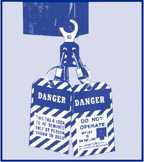
The Occupational Safety and Health Administration (OSHA) standard for The Control of Hazardous Energy (Lockout/Tagout), Title 29 Code of Federal Regulations (CFR) Part 1910.147, addresses the practices and procedures necessary to disable machinery or equipment, thereby preventing the release of hazardous energy while employees perform servicing and maintenance activities. The standard outlines measures for controlling hazardous energies - electrical, mechanical, hydraulic, pneumatic, chemical, thermal, and other energy sources.
In addition, 29 CFR 1910.333 sets forth requirements to protect employees working on electric circuits and equipment. This section requires workers to use safe work practices, including lockout and tagging procedures. These provisions apply when employees are exposed to electrical hazards while working on, near, or with conductors or systems that use electric energy.
Why is controlling hazardous energy sources important?
Employees servicing or maintaining machines or equipment may be exposed to serious physical harm or death if hazardous energy is not properly controlled. Craft workers, machine operators, and laborers are among the 3 million workers who service equipment and face the greatest risk. Compliance with the lockout/tagout standard prevents an estimated 120 fatalities and 50,000 injuries each year. Workers injured on the job from exposure to hazardous energy lose an average of 24 workdays for recuperation.
How can you protect workers?
The lockout/tagout standard establishes the employer’s responsibility to protect employees from hazardous energy sources on machines and equipment during service and maintenance. The standard gives each employer the flexibility to develop an energy control program suited to the needs of the particular workplace and the types of machines and equipment being maintained or serviced. This is generally done by affixing the appropriate lockout or tagout devices to energy-isolating devices and by deenergizing machines and equipment. The standard outlines the steps required to do this.
What do employees need to know?
Employees need to be trained to ensure that they know, understand, and follow the applicable provisions of the hazardous energy control procedures. The training must cover at least three areas: aspects of the employer’s energy control program; elements of the energy control procedure relevant to the employee’s duties or assignment; and the various requirements of the OSHA standards related to lockout/tagout.
What must employers do to protect employees?
The standards establish requirements that employers must follow when employees are exposed to hazardous energy while servicing and maintaining equipment and machinery. Some of the most critical requirements from these standards are outlined below:
• Develop, implement, and enforce an energy control program.
• Use lockout devices for equipment that can be locked out. Tagout devices may be used in lieu of lockout devices only if the tagout program provides employee protection equivalent to that provided through a lockout program.
• Ensure that new or overhauled equipment is capable of being locked out.
• Develop, implement, and enforce an effective tagout program if machines or equipment are not capable of being locked out.
• Develop, document, implement, and enforce energy control procedures. [See the note to 29 CFR 1910.147(c)(4)(i) for an exception to the documentation requirements.]
• Use only lockout/tagout devices authorized for the particular equipment or machinery and ensure that they are durable, standardized, and substantial.
• Ensure that lockout/tagout devices identify the individual users.
• Establish a policy that permits only the employee who applied a lockout/tagout device to remove it. [See 29 CFR 1910.147(e)(3) for exception.]
• Inspect energy control procedures at least annually.
• Provide effective training as mandated for all employees covered by the standard.
• Comply with the additional energy control provisions in OSHA standards when machines or equipment must be tested or repositioned, when outside contractors work at the site, in group lockout situations, and during shift or personnel changes.
How can you get more information?
OSHA has various publications, standards, technical assistance, and compliance tools to help you, and offers extensive assistance through its many safety and health programs: workplace consultation, voluntary protection programs, grants, strategic partnerships, state plans, training, and education. Guidance such as OSHA’s Safety and Health Management Program Guidelines identify elements that are critical to the development of a successful safety and health management system. This and other information are available on OSHA’s Website at www.osha.gov.
Reprinted from the OSHA Fact Sheet: Lockout/Tagout. This is one in a series of informational fact sheets highlighting OSHA programs, policies, or standards. For more information, visit www.osha.gov.
Publication date:08/20/2007

Report Abusive Comment